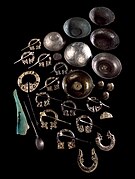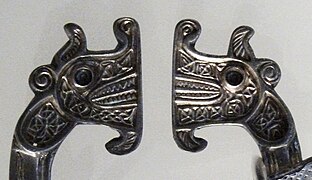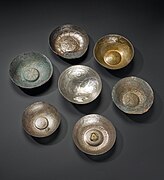geo.wikisort.org - Island
St Ninian's Isle is a small tied island connected by the largest tombolo in the UK[2] to the south-western coast of the Mainland, Shetland, in Scotland. It is part of the civil parish of Dunrossness on the South Mainland. The tombolo, known locally as an ayre[3] from the Old Norse for "gravel bank",[4] is 500 metres long.[5] During the summer the tombolo is above sea level and accessible to walkers. During winter, stronger wave action removes sand from the beach so that it is usually covered at high tide, and occasionally throughout the tidal cycle, until the sand is returned the following spring. Depending on the definition used, St. Ninian's is thus either an island, or a peninsula;[6] it has an area of about 72 hectares.
| Scottish Gaelic name | Unknown |
|---|---|
| Old Norse name | Unknown |
| Meaning of name | na |
| Location | |
| OS grid reference | HU365210 |
| Coordinates | 59.97°N 1.35°W |
| Physical geography | |
| Island group | Shetland |
| Area | c. 72 ha |
| Area rank | na [1] |
| Highest elevation | 53 m |
| Administration | |
| Sovereign state | United Kingdom |
| Country | Scotland |
| Council area | Shetland |
| Demographics | |
| Population | last inhabited 1796 |
The nearest settlement is Bigton, also in the parish of Dunrossness. The important early medieval St Ninian's Isle Treasure of metalwork, mostly in silver, was discovered under the church floor in 1958. Many seabirds, including puffins, visit the island, with several species nesting there.
History
As its name suggests, the island has ecclesiastical connections, which may like others in the Northern Isles, Hebrides and Faroes have connections to the Culdees or papar. However, the island's history is far older than Christianity, and Neolithic graves have been found within the walls of the chapel (formerly beneath the floor).
The ruins of a 12th-century chapel can still be seen near the end of the tombolo. The dedication is to Shetland's patron saint, the enigmatic Saint Ninian of Galloway, who is also widely venerated on the nearby Orkney Islands, and may be commemorated in the name of North Ronaldsay. In 1958, an excavation found a hoard of 8th century silver in the chapel grounds under a stone slab in a wooden box, which caused a renewed archaeological interest in the island.[7] It was suspected to have been buried to hide it from, or stolen in, a Viking raid. The remains of a pre-Norse chapel were also found, which may indicate some kind of Culdee presence.
The last family to live on the island, that of Henry Leask, left the island in 1796. Henry Leask was married twice and had 13 children.
St Ninian's Isle Treasure

The St Ninian's Isle Treasure was discovered under a cross-marked slab in the floor of the early St. Ninian's church, on 4 July 1958 by a local schoolboy, Douglas Coutts. Coutts was helping visiting archaeologists led by Professor A. C. O'Dell of Aberdeen University at a dig on the isle. The silver bowls, jewellery and other pieces, not all of which were probably new when deposited, are believed to date from c.750–825 AD.[8]
- Early medieval hoard of Pictish silver objects dated c AD 800
- pennanular brooch
- Bowl
- Chape
- Mounts
- Terminals of a brooch
- Penannular silver brooches
- Penannular silver bowls
See also
Notes
- Area and population ranks: there are c. 300 islands over 20 ha in extent and 93 permanently inhabited islands were listed in the 2011 census.
- St Ninian's Tombolo. J.D. Hansom, Coastal Geomorphology of Great Britain (2003). Extract from the Geological Conservation Review.
- Nicolson (1972) p. 21
- Guide to Scandinavian origins of place names in Britain. Archived 4 December 2008 at the Wayback Machine Ordnance Survey, 2004.
- "Get-a-map" Ordnance Survey
- Fettes College Shetland Landscapes Archived 30 August 2004 at the Wayback Machine Retrieved 3 August 2007.
- Haswell-Smith, Hamish. (2004) The Scottish Islands. Edinburgh. Canongate.
- "St Ninian's Isle Treasure". National Museums Scotland. Retrieved 5 December 2020.
References
- O'Dell, A. St. Ninian's Isle Treasure. a Silver Hoard Discovered on St. Ninian's Isle, Zetland on 4th July, 1958. Aberdeen University Studies. No. 141
- Nicolson, James R. (1972) Shetland. Newton Abbott. David & Charles.
- Youngs, Susan (ed), "The Work of Angels", Masterpieces of Celtic Metalwork, 6th–9th centuries AD, pp. 108–112, 1989, British Museum Press, London, ISBN 978-0-7141-0554-3
- Webster, Leslie, Anglo-Saxon Art, 2012, British Museum Press, ISBN 9780714128092
External links
| Wikimedia Commons has media related to St Ninian's Isle. |
- Photographs of the St Ninian's Isle Treasure, at the National Museums Scotland website
- Shetland Museum - Pictures of the treasure
- St Ninian's Isle - Shetland Heritage
- St Ninian's Isle Treasure on Shetlopedia
На других языках
- [en] St Ninian's Isle
[fr] Saint-Ninian
Saint-Ninian est une île-barrière du Royaume-Uni située dans l'archipel des Shetland. Le cordon littoral qui la relie à la côte sud-ouest des Shetland est le tombolo le plus long du Royaume-Uni[1]. L'île est rattachée à la paroisse civile de Dunrossness. Son tombolo, qualifié localement d’ayre[2] (mot emprunté au vieux norrois et signifiant « plage de cailloux[3] »), a une longueur de 500 m[4].[it] St Ninian's Isle
St Ninian's Isle è una piccola isola tidale collegata dal più esteso tombolo attivo nel Regno Unito[1] con la costa sud-occidentale di Mainland, nelle isole Shetland in Scozia. Il tombolo, conosciuto localmente come ayre,[2] che proviene dall'antico norreno e significa "greto",[3] è lungo 500 metri.[4] Durante l'estate il tombolo si trova al di sopra del livello del mare ed è accessibile a chi desidera percorrerlo. Durante l'inverno, la forte azione delle onde rimuove la sabbia dalla spiaggia; a seconda della definizione utilizzata, St Ninian's Isle può pertanto essere definita come isola o come penisola.[5] Ha un'area di circa 72 ettari e l'insediamento abitato più vicino è Bigton, su South Mainland. L'importante opera in metallo dell'Alto Medioevo, St Ninian's Isle Treasure, composta principalmente da argento, fu scoperta sotto il pavimento della chiesa nel 1958. Molte specie di uccelli, tra cui la pulcinella di mare, vivono sull'isola, e molte altre vi si riproducono.Другой контент может иметь иную лицензию. Перед использованием материалов сайта WikiSort.org внимательно изучите правила лицензирования конкретных элементов наполнения сайта.
WikiSort.org - проект по пересортировке и дополнению контента Википедии









